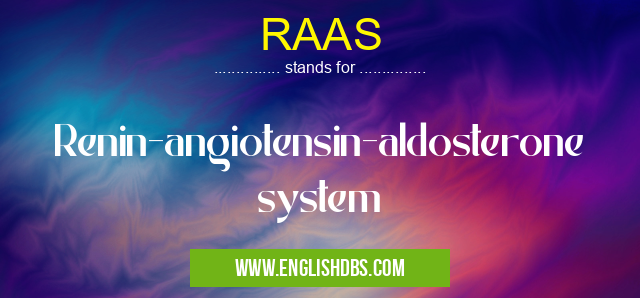What does RAAS mean in HOSPITALS
The Renin-Angiotensin-Aldosterone System (RAAS) is a complex system that helps to regulate blood pressure. It acts as an endocrine feedback loop to control the balance of sodium and water in the body. The RAAS consists of three hormones - renin, angiotensin, and aldosterone - that act on various organs throughout the body. It is important for maintaining blood volume, fluid balance, and electrolyte concentrations in our bodies. Without proper functioning of these hormones, dehydration or life-threatening conditions can occur.

RAAS meaning in Hospitals in Medical
RAAS mostly used in an acronym Hospitals in Category Medical that means Renin-angiotensin-aldosterone system
Shorthand: RAAS,
Full Form: Renin-angiotensin-aldosterone system
For more information of "Renin-angiotensin-aldosterone system", see the section below.
What is the RAAS? The Renin Angiotensin Aldosterone System (RAAS) is made up of three hormones
renin, angiotensin, and aldosterone. Renin is produced by the kidneys when they detect low levels of sodium in the bloodstream. This triggers a cascade of reactions that lead to increased levels of angiotensin, which then causes arterioles to constrict or narrow, leading to an increase in blood pressure. In addition, increased levels of angiotensin trigger the release of aldosterone from the adrenal gland, which helps maintain normal levels of salt and water throughout our bodies. Together, these three hormones help keep fluid and electrolyte balance within our bodies at a healthy level
Essential Questions and Answers on Renin-angiotensin-aldosterone system in "MEDICAL»HOSP"
What is the Renin-Angiotensin-Aldosterone System?
The Renin-Angiotensin-Aldosterone System (RAAS) is a hormonal system composed of the hormones renin, angiotensin, and aldosterone. These hormones work together to maintain healthy blood pressure levels and regulate electrolyte balance in the body. RAAS also helps to control water retention in the body to regulate blood volume.
What does Renin do?
Renin, an enzyme released by the kidneys, helps to convert a precursor hormone known as angiotensinogen into angiotensin I. This triggers an increase in adrenalin release, which leads to vasoconstriction and increased blood pressure.
What does Angiotensin do?
Angiotensin I is then converted to another active form of the hormone known as angiotensin II. Angiotensin II helps to further constrict blood vessels, thereby increasing blood pressure even more. It also stimulates production of aldosterone from the adrenal glands.
What does Aldosterone do?
Aldosterone works to pull sodium and water into cells from outside sources. This helps with maintenance of healthy fluid balance throughout the body and increases blood pressure even further.
Why is RAAS important?
RAAS is important for maintaining healthy blood pressure levels within the body and regulating electrolyte balance which can affect tissue function if it becomes imbalanced. It is also essential for controlling homeostasis (internal stability).
How does RAAS become activated?
RAAS typically becomes activated when there is a sudden decrease in renal perfusion or an increase in sodium concentration in the bloodstream. Activation leads to secretion of rennin from the kidneys which starts a chain reaction involving all three hormones (rennin, angiotensin, and aldosterone).
Are there any medications that act on RAAS?
Yes! There are many medications available that act on either one or multiple components of this hormonal system. Examples include ACE inhibitors which block conversion of angiotensin I into angiotension II; ARBs which block receptor sites for angiotension II; diuretics which reduce water retention caused by aldosterone; or mineralocorticoid receptor agonists/antagonists which directly activate/block receptor sites for aldosterone.
RAAS also stands for: |
|
| All stands for RAAS |
